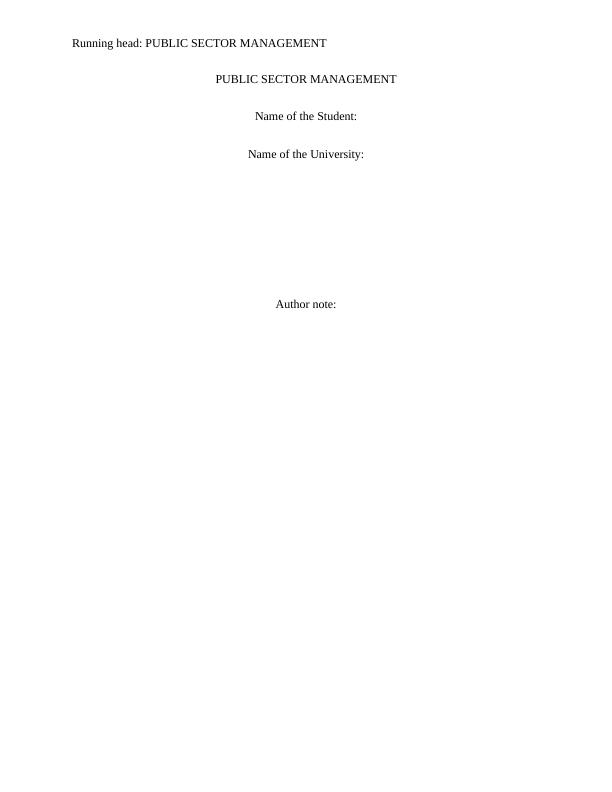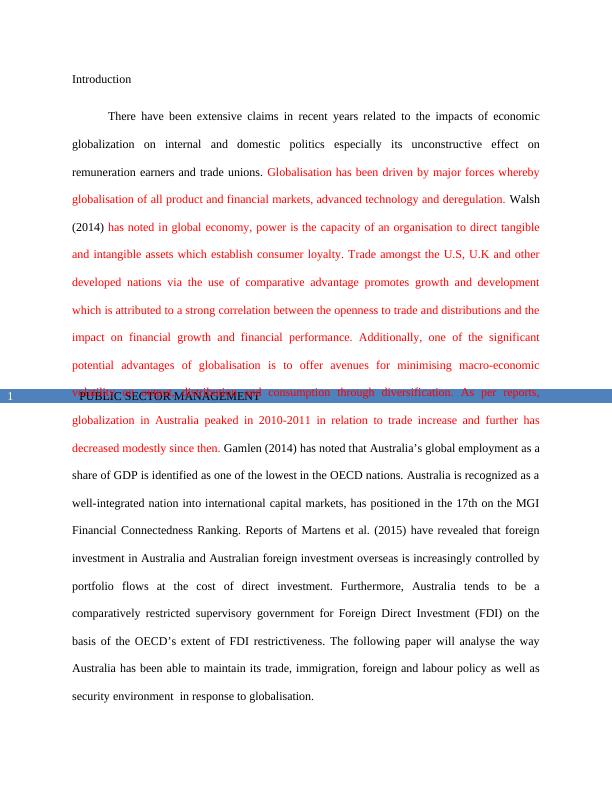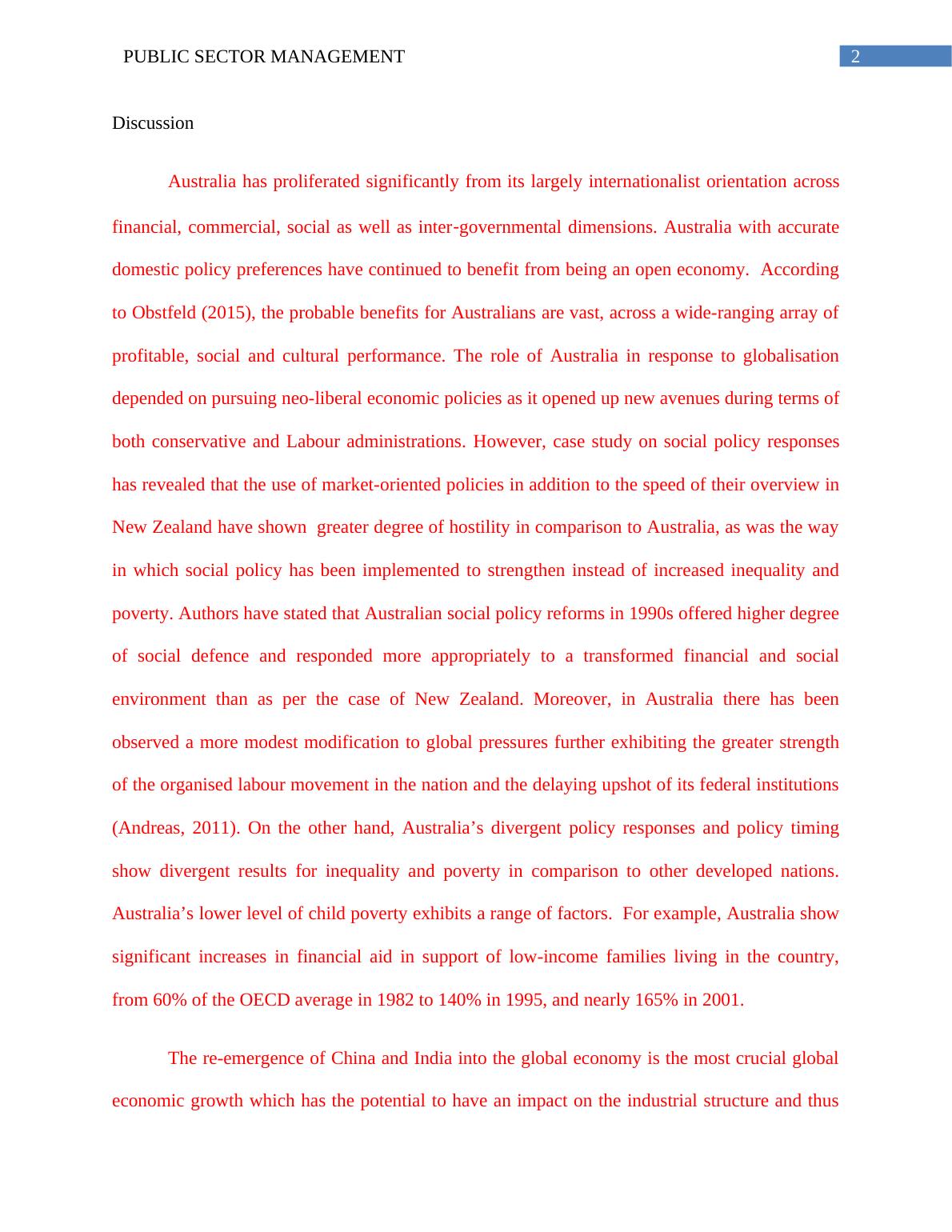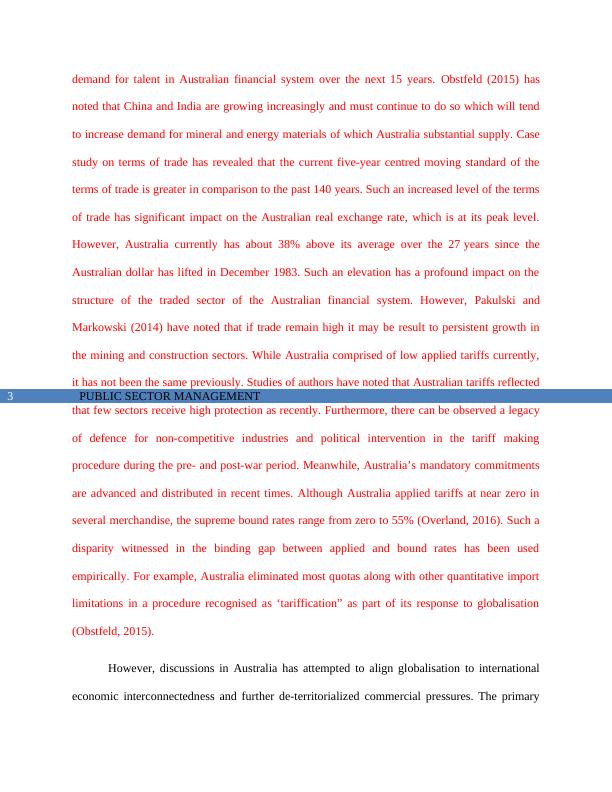Australia's Response to Globalisation: Maintaining Trade, Immigration, and Labour Policies
Added on 2022-12-09
14 Pages3936 Words225 Views
Running head: PUBLIC SECTOR MANAGEMENT
PUBLIC SECTOR MANAGEMENT
Name of the Student:
Name of the University:
Author note:
PUBLIC SECTOR MANAGEMENT
Name of the Student:
Name of the University:
Author note:

PUBLIC SECTOR MANAGEMENT1
Introduction
There have been extensive claims in recent years related to the impacts of economic
globalization on internal and domestic politics especially its unconstructive effect on
remuneration earners and trade unions. Globalisation has been driven by major forces whereby
globalisation of all product and financial markets, advanced technology and deregulation. Walsh
(2014) has noted in global economy, power is the capacity of an organisation to direct tangible
and intangible assets which establish consumer loyalty. Trade amongst the U.S, U.K and other
developed nations via the use of comparative advantage promotes growth and development
which is attributed to a strong correlation between the openness to trade and distributions and the
impact on financial growth and financial performance. Additionally, one of the significant
potential advantages of globalisation is to offer avenues for minimising macro-economic
volatility on output, distribution and consumption through diversification. As per reports,
globalization in Australia peaked in 2010-2011 in relation to trade increase and further has
decreased modestly since then. Gamlen (2014) has noted that Australia’s global employment as a
share of GDP is identified as one of the lowest in the OECD nations. Australia is recognized as a
well-integrated nation into international capital markets, has positioned in the 17th on the MGI
Financial Connectedness Ranking. Reports of Martens et al. (2015) have revealed that foreign
investment in Australia and Australian foreign investment overseas is increasingly controlled by
portfolio flows at the cost of direct investment. Furthermore, Australia tends to be a
comparatively restricted supervisory government for Foreign Direct Investment (FDI) on the
basis of the OECD’s extent of FDI restrictiveness. The following paper will analyse the way
Australia has been able to maintain its trade, immigration, foreign and labour policy as well as
security environment in response to globalisation.
Introduction
There have been extensive claims in recent years related to the impacts of economic
globalization on internal and domestic politics especially its unconstructive effect on
remuneration earners and trade unions. Globalisation has been driven by major forces whereby
globalisation of all product and financial markets, advanced technology and deregulation. Walsh
(2014) has noted in global economy, power is the capacity of an organisation to direct tangible
and intangible assets which establish consumer loyalty. Trade amongst the U.S, U.K and other
developed nations via the use of comparative advantage promotes growth and development
which is attributed to a strong correlation between the openness to trade and distributions and the
impact on financial growth and financial performance. Additionally, one of the significant
potential advantages of globalisation is to offer avenues for minimising macro-economic
volatility on output, distribution and consumption through diversification. As per reports,
globalization in Australia peaked in 2010-2011 in relation to trade increase and further has
decreased modestly since then. Gamlen (2014) has noted that Australia’s global employment as a
share of GDP is identified as one of the lowest in the OECD nations. Australia is recognized as a
well-integrated nation into international capital markets, has positioned in the 17th on the MGI
Financial Connectedness Ranking. Reports of Martens et al. (2015) have revealed that foreign
investment in Australia and Australian foreign investment overseas is increasingly controlled by
portfolio flows at the cost of direct investment. Furthermore, Australia tends to be a
comparatively restricted supervisory government for Foreign Direct Investment (FDI) on the
basis of the OECD’s extent of FDI restrictiveness. The following paper will analyse the way
Australia has been able to maintain its trade, immigration, foreign and labour policy as well as
security environment in response to globalisation.

PUBLIC SECTOR MANAGEMENT2
Discussion
Australia has proliferated significantly from its largely internationalist orientation across
financial, commercial, social as well as inter‐governmental dimensions. Australia with accurate
domestic policy preferences have continued to benefit from being an open economy. According
to Obstfeld (2015), the probable benefits for Australians are vast, across a wide-ranging array of
profitable, social and cultural performance. The role of Australia in response to globalisation
depended on pursuing neo-liberal economic policies as it opened up new avenues during terms of
both conservative and Labour administrations. However, case study on social policy responses
has revealed that the use of market-oriented policies in addition to the speed of their overview in
New Zealand have shown greater degree of hostility in comparison to Australia, as was the way
in which social policy has been implemented to strengthen instead of increased inequality and
poverty. Authors have stated that Australian social policy reforms in 1990s offered higher degree
of social defence and responded more appropriately to a transformed financial and social
environment than as per the case of New Zealand. Moreover, in Australia there has been
observed a more modest modification to global pressures further exhibiting the greater strength
of the organised labour movement in the nation and the delaying upshot of its federal institutions
(Andreas, 2011). On the other hand, Australia’s divergent policy responses and policy timing
show divergent results for inequality and poverty in comparison to other developed nations.
Australia’s lower level of child poverty exhibits a range of factors. For example, Australia show
significant increases in financial aid in support of low-income families living in the country,
from 60% of the OECD average in 1982 to 140% in 1995, and nearly 165% in 2001.
The re-emergence of China and India into the global economy is the most crucial global
economic growth which has the potential to have an impact on the industrial structure and thus
Discussion
Australia has proliferated significantly from its largely internationalist orientation across
financial, commercial, social as well as inter‐governmental dimensions. Australia with accurate
domestic policy preferences have continued to benefit from being an open economy. According
to Obstfeld (2015), the probable benefits for Australians are vast, across a wide-ranging array of
profitable, social and cultural performance. The role of Australia in response to globalisation
depended on pursuing neo-liberal economic policies as it opened up new avenues during terms of
both conservative and Labour administrations. However, case study on social policy responses
has revealed that the use of market-oriented policies in addition to the speed of their overview in
New Zealand have shown greater degree of hostility in comparison to Australia, as was the way
in which social policy has been implemented to strengthen instead of increased inequality and
poverty. Authors have stated that Australian social policy reforms in 1990s offered higher degree
of social defence and responded more appropriately to a transformed financial and social
environment than as per the case of New Zealand. Moreover, in Australia there has been
observed a more modest modification to global pressures further exhibiting the greater strength
of the organised labour movement in the nation and the delaying upshot of its federal institutions
(Andreas, 2011). On the other hand, Australia’s divergent policy responses and policy timing
show divergent results for inequality and poverty in comparison to other developed nations.
Australia’s lower level of child poverty exhibits a range of factors. For example, Australia show
significant increases in financial aid in support of low-income families living in the country,
from 60% of the OECD average in 1982 to 140% in 1995, and nearly 165% in 2001.
The re-emergence of China and India into the global economy is the most crucial global
economic growth which has the potential to have an impact on the industrial structure and thus

PUBLIC SECTOR MANAGEMENT3
demand for talent in Australian financial system over the next 15 years. Obstfeld (2015) has
noted that China and India are growing increasingly and must continue to do so which will tend
to increase demand for mineral and energy materials of which Australia substantial supply. Case
study on terms of trade has revealed that the current five-year centred moving standard of the
terms of trade is greater in comparison to the past 140 years. Such an increased level of the terms
of trade has significant impact on the Australian real exchange rate, which is at its peak level.
However, Australia currently has about 38% above its average over the 27 years since the
Australian dollar has lifted in December 1983. Such an elevation has a profound impact on the
structure of the traded sector of the Australian financial system. However, Pakulski and
Markowski (2014) have noted that if trade remain high it may be result to persistent growth in
the mining and construction sectors. While Australia comprised of low applied tariffs currently,
it has not been the same previously. Studies of authors have noted that Australian tariffs reflected
that few sectors receive high protection as recently. Furthermore, there can be observed a legacy
of defence for non-competitive industries and political intervention in the tariff making
procedure during the pre- and post-war period. Meanwhile, Australia’s mandatory commitments
are advanced and distributed in recent times. Although Australia applied tariffs at near zero in
several merchandise, the supreme bound rates range from zero to 55% (Overland, 2016). Such a
disparity witnessed in the binding gap between applied and bound rates has been used
empirically. For example, Australia eliminated most quotas along with other quantitative import
limitations in a procedure recognised as ‘tariffication” as part of its response to globalisation
(Obstfeld, 2015).
However, discussions in Australia has attempted to align globalisation to international
economic interconnectedness and further de-territorialized commercial pressures. The primary
demand for talent in Australian financial system over the next 15 years. Obstfeld (2015) has
noted that China and India are growing increasingly and must continue to do so which will tend
to increase demand for mineral and energy materials of which Australia substantial supply. Case
study on terms of trade has revealed that the current five-year centred moving standard of the
terms of trade is greater in comparison to the past 140 years. Such an increased level of the terms
of trade has significant impact on the Australian real exchange rate, which is at its peak level.
However, Australia currently has about 38% above its average over the 27 years since the
Australian dollar has lifted in December 1983. Such an elevation has a profound impact on the
structure of the traded sector of the Australian financial system. However, Pakulski and
Markowski (2014) have noted that if trade remain high it may be result to persistent growth in
the mining and construction sectors. While Australia comprised of low applied tariffs currently,
it has not been the same previously. Studies of authors have noted that Australian tariffs reflected
that few sectors receive high protection as recently. Furthermore, there can be observed a legacy
of defence for non-competitive industries and political intervention in the tariff making
procedure during the pre- and post-war period. Meanwhile, Australia’s mandatory commitments
are advanced and distributed in recent times. Although Australia applied tariffs at near zero in
several merchandise, the supreme bound rates range from zero to 55% (Overland, 2016). Such a
disparity witnessed in the binding gap between applied and bound rates has been used
empirically. For example, Australia eliminated most quotas along with other quantitative import
limitations in a procedure recognised as ‘tariffication” as part of its response to globalisation
(Obstfeld, 2015).
However, discussions in Australia has attempted to align globalisation to international
economic interconnectedness and further de-territorialized commercial pressures. The primary

End of preview
Want to access all the pages? Upload your documents or become a member.
Related Documents
Trade and Internationallg...
|7
|1333
|384
Analysis of China's Political Economy for Foreign Direct Investmentlg...
|13
|2254
|302
Comparative Analysis of Macroeconomic Performance of Australia and New Zealandlg...
|20
|3563
|292
Australian Trade Policy: Advantages and Disadvantageslg...
|14
|3435
|232
Economic, Political, and Legal Factors for Foreign Direct Investment in Australialg...
|9
|1610
|383
International Business- Essay 3lg...
|5
|1069
|214
